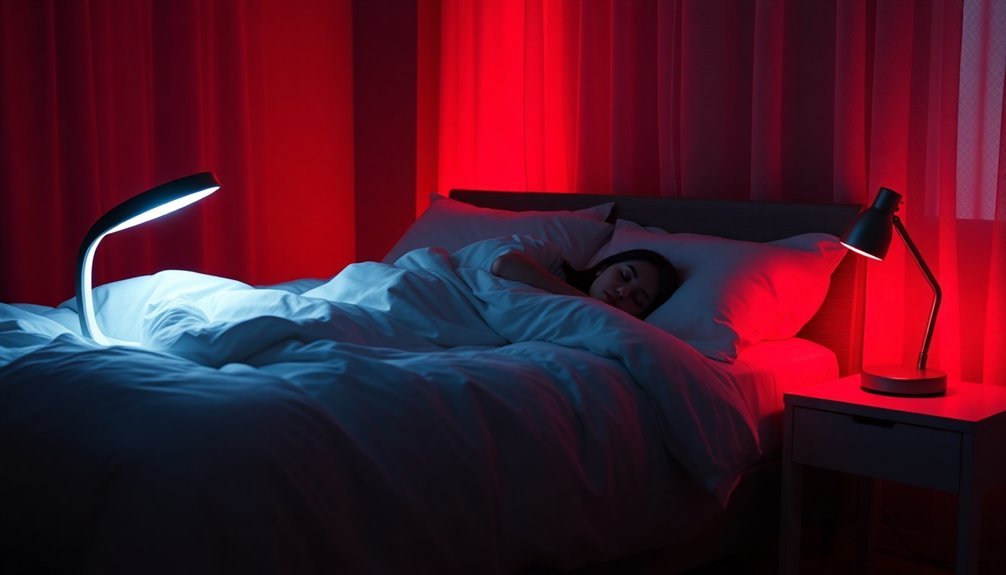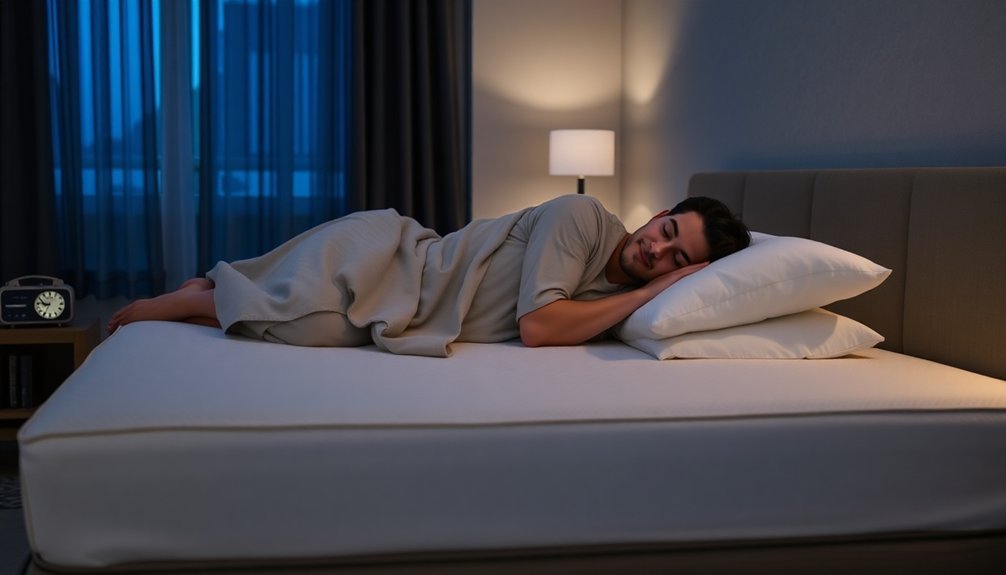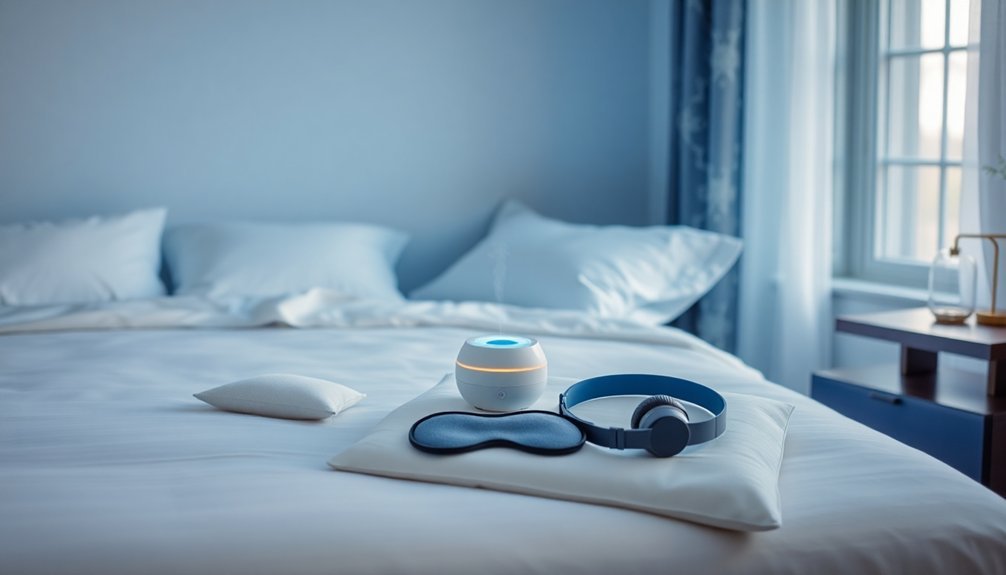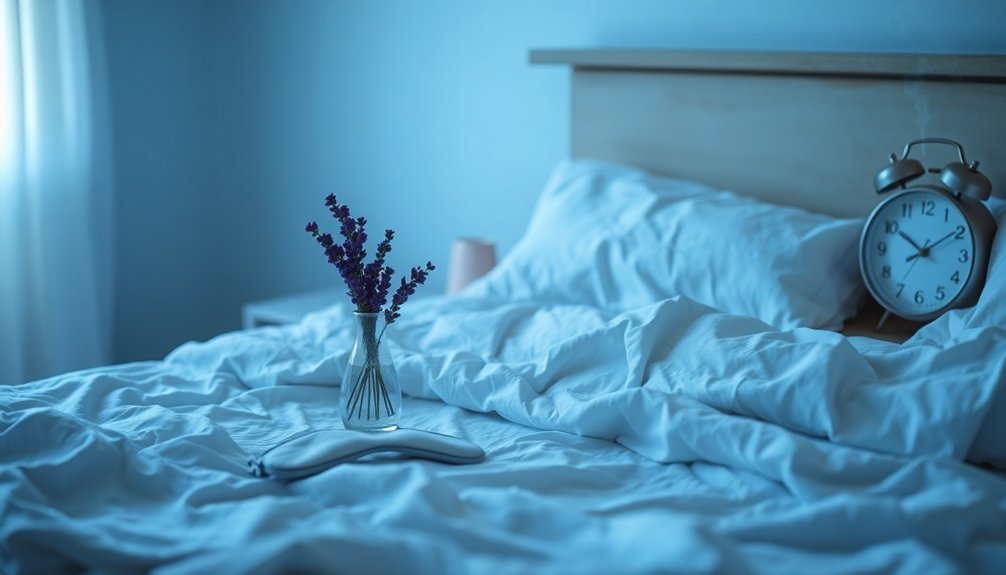Red light therapy can substantially improve your sleep quality by boosting melatonin production and regulating key sleep hormones. To create your own sleep sanctuary, start by setting up a dark, quiet space with blackout curtains and minimal electronics. You'll want to time your therapy sessions between 8 p.m. and midnight, maintaining proper sleep positions with appropriate pillow support. Track your progress using wearable devices or sleep apps to monitor improvements in your rest patterns. Consider combining this approach with cognitive behavioral therapy techniques and good sleep hygiene habits to maximize your results. The path to deeper, more restorative sleep awaits.
Understanding Red Light Sleep Benefits

Anyone seeking better sleep should consider red light therapy, a scientifically-backed method that's revolutionizing how we approach rest. Unlike harmful blue light that disrupts your sleep patterns, red light therapy works with your body's natural processes to enhance sleep quality and duration.
You'll experience improved melatonin production, your body's natural sleep hormone, which helps regulate your sleep-wake cycles and synchronize your circadian rhythms. Originally developed by NASA for healing wounds, this therapy has evolved into a powerful tool for sleep enhancement.
Red light therapy also boosts your serotonin levels while reducing cortisol, creating an ideal chemical balance for restful sleep. This dual action helps combat both anxiety and seasonal affective disorder (SAD), making it easier for you to wind down at night.
When you use red light therapy consistently, you can expect to fall asleep faster and stay asleep longer – adding an average of 34 minutes to your nightly rest. It's particularly effective against sleep disorders like insomnia and sleep apnea.
For the best results, you'll want to use a device emitting 600-700 nanometers for 20-30 minutes before bedtime, positioned 6-18 inches from your skin. Remember to dim other lights to minimize blue light exposure.
Setting Up Your Therapy Space
Creating an ideal sleep sanctuary starts with setting up your therapy space according to scientifically proven principles. You'll need to focus on four key elements: darkness, noise control, temperature management, and room organization.
Start by making your room as dark as possible using blackout curtains or shades. If you need minimal lighting, opt for dim red lights instead of bright white ones. Remove or cover any electronics that emit light.
For noise management, you'll want to create a quiet atmosphere using white noise machines or earplugs if external sounds are an issue. Consider soundproofing materials for persistent noise problems.
Maintain a cool, consistent temperature in your therapy space, ensuring proper ventilation while avoiding drafts. You'll sleep better in a room that's neither too hot nor too cold. Consider using weighted blankets for additional comfort and stress relief.
Keep your space clutter-free and organized, as this promotes relaxation and better sleep quality. Choose soothing colors for your walls and bedding, and invest in a comfortable mattress and pillows.
Add calming scents like lavender to enhance the sleep-inducing environment. Remember to minimize electronic devices in your bedroom, as they can interfere with your sleep quality.
Optimal Treatment Times and Positions

Timing and positioning play crucial roles in the effectiveness of deep sleep therapy. You'll want to start your sleep period between 8 p.m. and midnight, as this timeframe offers the best opportunity for restorative rest.
Plan to spend about an hour moving into deep sleep stages, so factor this into your schedule.
Your time in bed (TIB) should match your average sleep duration, with a minimum of 5 hours. You'll need to adjust this weekly based on your sleep efficiency (SE). If you're achieving 90% SE (85% for older adults), you can increase your TIB by 15-30 minutes.
Keep your TIB the same if your SE falls between 85-90% (80-85% for older adults), and reduce it if you're below these thresholds.
For ideal positioning, sleep on your side to maintain your spine's natural curve. Place a small pillow at your neck's base and another between your knees for proper alignment. Switch sides periodically to prevent any numbness in your extremities.
While back sleeping can work with proper support (like a cylindrical pillow under your knees), avoid stomach sleeping as it can strain your neck and back.
These positioning adjustments will help maximize your deep sleep quality.
Monitoring Sleep Quality Progress
Monitoring your sleep quality progress requires a combination of tools and tracking methods to guarantee the effectiveness of deep sleep therapy. You'll need to track both objective and subjective data to get a complete picture of your sleep improvements.
Start by using wearable devices that monitor your heart rate, movement, and sleep stages. These devices can provide detailed insights into your deep sleep duration and overall sleep architecture. Setting up smart alarm features can help you wake up during lighter sleep phases, minimizing morning grogginess.
Combine this data with subjective assessments using sleep questionnaires like the PSQI to document how you feel about your sleep quality.
Keep a detailed record of environmental and lifestyle factors that affect your sleep. Track room temperature, light exposure, caffeine intake, and stress levels. This information will help you identify patterns and make necessary adjustments to optimize your deep sleep therapy.
Use sleep monitoring apps that integrate data from various sources to generate thorough sleep reports. These apps can help you spot trends over weeks or months, showing how your sleep quality improves with continued therapy.
Pay special attention to metrics like time spent in deep sleep, number of nighttime awakenings, and your overall sleep efficiency score.
Combining Therapies for Maximum Results

Successful deep sleep therapy often relies on combining multiple treatment approaches for ideal results. When you're seeking the most effective treatment for insomnia, combining Cognitive Behavioral Therapy (CBT) with appropriate medication can offer superior outcomes compared to using either method alone.
While both CBT alone and combined therapy with medication (such as zolpidem) can markedly improve your sleep quality, the combination approach typically leads to higher remission rates during extended therapy. Good sleep hygiene education covering caffeine and alcohol effects is an essential component of comprehensive CBT treatment.
The key is to start with combined therapy and then gradually shift to CBT alone, as this strategy has shown the best long-term success rates.
If you're considering this approach, you'll want to work with your healthcare provider to develop a plan that includes medication tapering while maintaining CBT. This combination has proven to maintain improvements for up to two years after treatment completion.
You can also explore digital CBT options (dCBT-I) alongside medication, which offers more flexibility in your treatment schedule. Remember that occasional CBT booster sessions might help optimize your long-term results, especially after you've discontinued medication use.
Frequently Asked Questions
Can Deep Sleep Therapy Help With Sleepwalking or Night Terrors?
Yes, deep sleep therapy can help reduce your sleepwalking and night terrors by addressing underlying stress, improving sleep quality, and using techniques like scheduled awakenings and relaxation exercises to prevent episodes.
Is Deep Sleep Therapy Safe During Pregnancy?
You shouldn't undergo deep sleep therapy during pregnancy without consulting your doctor. While positional sleep therapy shows promise, there's limited research on deep sleep's safety for pregnant women and their developing babies.
How Long Does It Take to See Results From Deep Sleep Therapy?
You'll typically notice initial improvements within 2-8 weeks of consistent deep sleep therapy. However, you may feel some benefits sooner, depending on your commitment level and individual factors affecting your sleep patterns.
Does Insurance Typically Cover Deep Sleep Therapy Treatments?
You'll need to check with your insurance provider, as coverage varies. While many insurers cover sleep-related treatments like CPAP therapy and oral appliances, it is crucial to confirm specific coverage before starting any treatment.
Can Children Undergo Deep Sleep Therapy?
Yes, your child can safely undergo deep sleep therapy. It's particularly effective for kids with sleep disorders, and professionals can tailor techniques like CBT-I and graduated extinction methods to your child's specific needs and age.
In Summary
You've taken an important step toward improving your sleep quality through deep sleep therapy. By implementing red light exposure, creating a dedicated space, following ideal timing, and tracking your progress, you're well on your way to better rest. Remember to be consistent with your routine and don't hesitate to combine different therapeutic approaches. Your journey to restorative sleep starts with these simple but effective strategies.





Leave a Reply